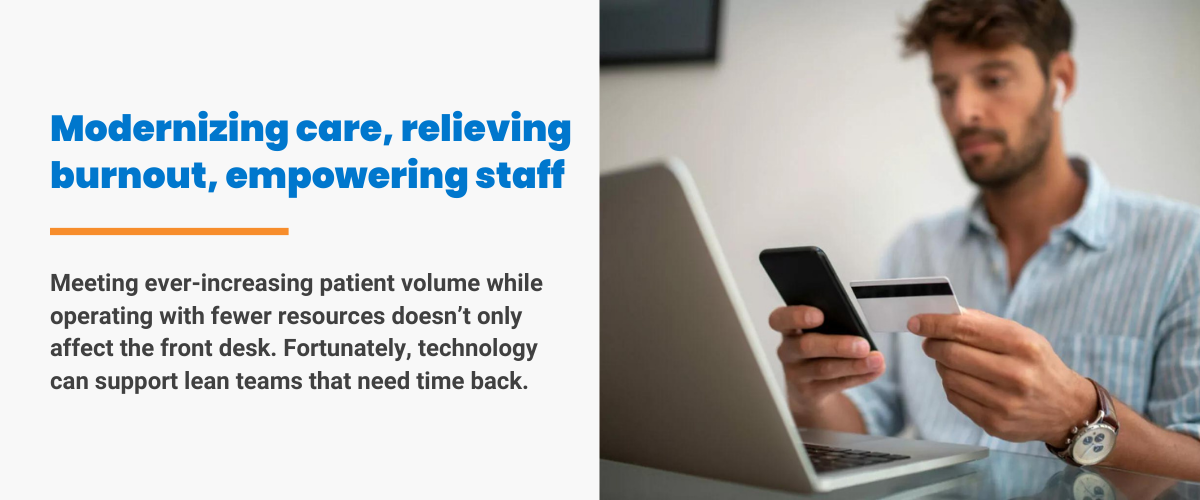The practice of the future values ease, speed, and safety, but most of all, people including front-desk staff, practitioners, and patients. More than minimalist in design and technology-driven, future-proofed practices facilitate meaningful connections with empathy that transcends obstacles. We know technology can be daunting. It’s often another thing to learn on a day that doesn’t come, but it doesn’t have to be this way, especially if you’re looking to avoid data entry that makes your eyes glaze over!
The healthcare industry has seen a dramatic reduction in workforces due in part to burned-out, overburdened practice staff, nurses, and providers. Organizations may not be able to consider what the future holds and if they can pivot. As practices evolve to accommodate changing business needs, automation, simply defined as technology that takes on an otherwise manual task, is the key to tackling many obstacles.
Healthcare is reeling from the disruption related to staffing shortages. According to Morse, “The U.S. Bureau of Labor Statistics released job numbers (…) showing that healthcare is among the top three industries cited in a 3% rise in the monthly ‘quits rate’, matching a high from September. The number of quits surged to 4.53 million for the month” (Morse, 2022). These losses significantly impact healthcare organizations like yours, as they must now operate with fewer people to respond to increased patient volume. Relief may be closer than you might think.
Despite staffing challenges, employees are finding ways to thrive with new automation-oriented technology that liberates them from manual, on-site administrative tasks and elevates their roles to emphasize patient care.
Why People Are Leaving Their Jobs
There is a myriad of reasons why people are leaving their jobs. There has been internal resistance to remote work that has taken a toll on employees on the front lines of healthcare, but that’s not all. Some people are reporting increased pressure at work that stems from large volumes of work and tense organizational environments.
While mass labor shortages have increased workloads for employees that remain active and that have had to work harder to make up for fewer resources, the adoption of automation can encourage employees to persevere in changing times. With more employees working from home, this automation has become essential to navigating the transition to remote work. According to BrandPost, “Process automation can streamline business practices, simplify routine workflows, and drive digital transformation to empower more effective remote work” (BrandPost, 2021). This form of automation saves time for those who work in the office and for those who are remote, offering a solution to challenges understaffed organizations face.
Elevation with Automation
Automation doesn’t need to replace people. In the future-ready practice, team members can utilize technology for their benefit. They need not fear that technology will render them irrelevant. In fact, with more time to prioritize patient care, staff will be positioned to increase productivity. In other words, you can reduce keystrokes and take a real lunch break!
Practices often ask how the benefits of automation will work for them, and if learning how to utilize it will truly create ease at the front desk. HIPAA Journal states, “The efficiencies that are introduced through automation mean clinicians can treat more patients in less time, and staff burnout can be reduced, which is all too common in the healthcare industry” (HIPAA Journal, n. d.). Those efficiencies include digitizing patient check-in and checkout processes, centralizing reporting, automatically posting payments across practice management systems, and automating patient payments.

Modernizing Care, Relieving Burnout, Empowering Staff
Meeting ever-increasing patient volume while operating with fewer resources doesn’t only affect the front desk. Fortunately, technology can support lean teams that need time back. According to HIPAA Journal, “Labor-intensive processes can be streamlined, paperwork can be reduced, and the amount of time clinicians spend on administrative tasks can be significantly reduced, which means physicians and nurses get more face-to-face time with patients” (HIPAA Journal, n. d.). With patient care as a priority, automation made possible by technology gives you the space to spend more time with them.
The future-ready practice minimizes redundancy and maximizes care. Administrative processes at the front desk of the past may not have been synonymous with efficiency, but they can be now. Everyone benefits when staff can focus less on heavy data entry and more on meaningful patient interactions. This focus can also empower staff to achieve more with digital tools that may not have been previously available or may have been underutilized.
Let Rectangle Health Be Your Guide to Modernizing Your Practice
Convenience is within reach with Rectangle Health’s Practice Management Bridge®, a payment and engagement platform that auto-posts payments to your practice management system and creates a centralized hub for transaction lookup and friction-free voids and refunds. Reporting and batching out with Practice Management Bridge is simple and effective, allowing for ease of reconciliation and end-of-day settlement. This easy-to-use platform has many automated features that are designed for administrative ease, increased information security, and reduced physical contact.
Automation-oriented features found in the Practice Management Bridge include Text-to-Pay, customizable messages, Card on File, patient financing, contactless capabilities, and digital registration forms. Learn more about how our solutions can free up staff time by scheduling a demo.
References
- Morse, S. (2022, January 5). Healthcare second largest sector hit by Great Resignation. Healthcare Finance News. Retrieved 1/19/2022, from https://www.healthcarefinancenews.com/news/healthcare-second-largest-sector-hit-great-resignation
- (2021, January 18). Empowering a Remote Workforce with Process Automation. CIO Magazine. Retrieved 12/14/2021, from https://www.cio.com/article/191241/empowering-a-remote-workforce-with-process-automation.html



